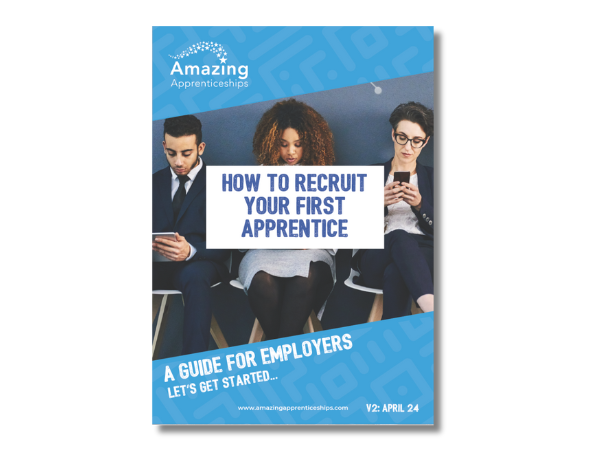Getting Started
Understanding the Key Steps When Recruiting an Apprentice
Use the answers to the FAQs below to work through the key steps when recruiting an apprentice, from exploring apprenticeship standards and finding a training provider to advertising your first vacancy.
We’ve got you covered.
Getting Started
When you first decide to take on an apprentice there will be lots of new information, terminology and advice to navigate.
We’ve put together this helpful free guide for employers which sets out the key steps involved, with useful links and tips.
Don’t forget to check out the FAQs below to see some of the top questions that employers ask.

Frequently Asked Questions
How much does an apprenticeship cost?
The costs involved with apprenticeships can vary, depending on a number of factors. These include:
- How many positions you are creating
- The size of your organisation
- If you pay the apprenticeship levy
- The salary and benefits you decide to offer
- The time that you and colleagues will put into developing the apprentice
- Any back-fill costs for when the apprentice is off-the-job
- The age of the apprentice
- Additional qualification costs from the training provider
It will be important to work through all of these factors to determine a more accurate cost for your organisation.
Is there any government funding for apprenticeships?
You may be eligible to access a government payment of £1,000, depending on the apprentice you hire. This is available for employers taking on an apprentice aged 16-18 or who is 19-24 with an Education Health & Care (EHC) Plan or a care leaver.
Depending on the age of your apprentice, the size of your organisation and whether you pay the apprenticeship levy or not, you may also be able to receive funding towards the cost of training and assessment. If you do not pay the apprenticeship levy, you may need to pay 5% of the training costs, with the government paying for the remaining 95%.
There is also a scheme called ‘levy transfer’ where 100% of your training costs could be paid by another employer. Please see below.
Visit Gov.uk to access the latest information about the funding available to support apprenticeship training.
How does levy transfer work?
Large employers that pay the apprenticeship levy can choose to transfer up to 50% of their levy funds each year to other businesses, to pay for their apprenticeship training and assessment.
Transferring levy funds is a way of supporting other businesses by deciding which sectors, skills or local areas you’d like to fund.
For example, you could support the engineering sector across England, or fund digital apprenticeships in your local area, or support any apprenticeships in a particular town or city. Which businesses and apprenticeships you support with a transfer is your choice.
Visit Gov.uk to access the latest information about the funding available to support apprenticeship training.
How do you decide on salary and benefits?
When recruiting a new apprentice, employers are able to decide how much they wish to pay their apprentices, so long as it complies with National Minimum Wage requirements for the individual.
Establishing your apprentice’s starting salary is an important decision for an employer. The salary will be a key part of the overall package that you offer, but you can also consider the other ways to make your position attractive to potential candidates. You could do some research into other vacancies:
- What salary + benefits are other employers offering for similar vacancies?
- Have you spoken to your training provider about previous positions that they have helped employers to advertise? What worked well?
How do you find the most appropriate standard?
There are more than 700 different apprenticeship standards to select from. The apprenticeship standard that you choose will need to reflect the knowledge, skills and behaviours (KSB’s) that your apprentice will develop during their apprenticeship.
A great place to start is the Institute for Apprenticeships and Technical Education website.
Your training provider will be able to support you to narrow down the most appropriate standard for your apprentice and will take into consideration the appropriate level and any prior learning or experience.
How do you select a training provider?
An apprenticeship training provider works with employers and the apprentice to help plan the overall apprenticeship, and to deliver the off-the-job learning that will help your apprentice to develop new skills and gain valuable workplace experience.
If you are not already working with a training provider, you will need to start researching which providers offer the apprenticeship standard that you would like to use, and you will ultimately need to select which provider you want to work with to deliver your apprenticeship.
How do you set up and use your apprenticeship account?
All employers must register an account with the government in order to offer apprenticeships.
Your apprenticeship account will be used to access and administer all apprenticeship funding and is a mandatory part of the apprenticeship process.
It is free of charge and quick to set up. Please find further information here.
How do you advertise your vacancy?
As part of your apprenticeship account on gov.uk, you can create vacancies that will appear on Find an apprenticeship – the government’s apprenticeships jobs site. Potential candidates can use this platform to search and apply for vacancies that they are interested in.
In addition to Find an apprenticeship, there are other ways that you can promote your vacancies, including through your existing employees, on your company website, through social media, by notifying local schools and colleges and through the DWP ‘Advertise a job’ platform.
Amazing Apprenticeships can also assist you to promote your vacancies. Get in contact with us below to discuss how we can support you.